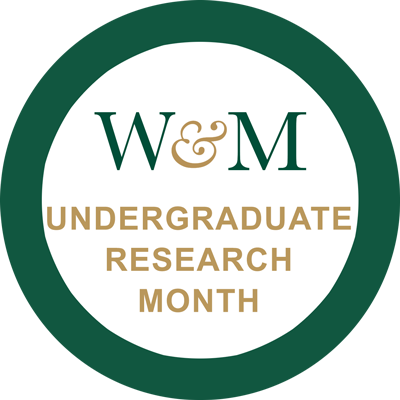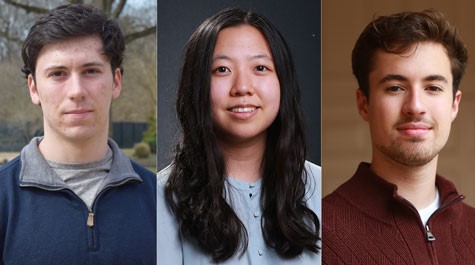Three undergraduate researchers selected for elite Goldwater Scholars Program
Three William & Mary students have been named Goldwater Scholars, joining a select group of undergraduates studying the natural sciences, mathematics and engineering.
William & Mary’s Goldwater Scholars for 2021 are Titouan Duston ’22, Elizabeth Li ’21 and Luke Mrini ’23. The awardees outlined their career goals in their applications for the Goldwater: Duston intends to pursue research in physical and computational chemistry and earn a Ph.D. to teach at a university level. Li says that she is aiming for a M.D./Ph.D.in systems biology to work at the intersection of medicine and research. Mrini will work toward a Ph.D. to teach at the university level and conduct research in high-energy theoretical physics.
 “We are extremely proud of all of our winners this year and we’re particularly excited that so many disciplines are represented,” said Lindsey Love. “Having our students win Goldwater Scholarships is a reflection of the outstanding undergraduate research experience at William & Mary.”
“We are extremely proud of all of our winners this year and we’re particularly excited that so many disciplines are represented,” said Lindsey Love. “Having our students win Goldwater Scholarships is a reflection of the outstanding undergraduate research experience at William & Mary.”
Love is the university’s representative to the Barry Goldwater Scholarship and Excellence in Education Foundation as well as the director of National Scholarships at William & Mary’s Roy R. Charles Center. She points out that having three Goldwater Scholars is a mark of pride for William & Mary, as rules for Goldwater Scholars permit an institution to nominate only four students — five, if one of the nominees is a transfer student.
The Goldwater Foundation stated in a March 26 press release announcing the scholarships that the 410 honorees were selected from 1,256 natural science, engineering and mathematics students nominated by 438 academic institutions. The release noted that past Goldwater Scholars have been awarded 94 Rhodes Scholarships, 150 Marshall Scholarships, 170 Churchill Scholarships, 109 Hertz Fellowships, and numerous other distinguished awards such as the National Science Foundation Graduate Research Fellowships.
The Barry Goldwater Scholarship and Excellence in Education Foundation was established by Congress in 1986
Titouan Duston
Titouan Duston listed participation in three ongoing research projects with faculty in William & Mary’s Department of Chemistry. One led to a paper published in a peer-reviewed journal, with Duston as co-author.
“Since early on, I’ve known that my interests lie on the border between chemistry and physics. At this level, science allows us to understand and describe chemical interactions at their most fundamental level. I’m most interested in studying the dynamics of chemical reactions,” Duston wrote in his Goldwater application. “Unfortunately, there is no undergraduate course of study which lies between chemistry and physics; thus, I’ve opted to study both. This decision has done me well— as my most enlightening courses thus far have come from both the physics and chemistry departments.”
Robert Pike, professor of chemistry, mentored Duston in his research and the two are co-authors on a paper. Pike said that Duston showed promise beginning in his freshman year.
“Experimental design seemed to come very naturally to him,” Pike wrote in his letter of endorsement. “This is very unusual ability in a senior research student, let alone a freshman.”
Another chemist, Nathan Kidwell, pointed out that Duston was the first sophomore to take his Physical Chemistry course — and earned the highest grade in the class. Duston joined Kidwell’s lab, proving to be a valued contributor.
“Primarily on his own, he has learned the theory and process of calculating theoretical calculations to predict the absorption properties and outcomes of molecular chromophores in ‘brown carbon’ aerosols,” Kidwell wrote. “These flexible nitrogen-heterocycles are implicated as major light-absorbing molecules that steer the optical properties of ‘brown carbon’ aerosols.”
Beverly Sher, senior lecturer in chemistry, wrote about Duston’s contributions to her interdisciplinary journal club course which focused on papers about the human microbiota.
“Titouan was the only student in the class who had not taken any biology courses in college,” she wrote. “His strength in chemistry, though, helped him to make important contributions to class discussion, as he often noticed important details that his more biologically-oriented classmates missed, and his lack of biological preconceptions, as well as his comfort with asking questions to which he did not already know the answers, helped his peers understand each of the papers we read more deeply.”
Elizabeth Li
Elizabeth Li wrote in her application that she first heard about synthetic biology from her high school biology teacher. It was less than a decade after the first self-replicating synthetic bacterial cell had been achieved.
“Everything felt so awe-inducing as I first opened my eyes to this field and this fascination only continued to grow as I learned more about researchers redesigning cells, tissues and whole organisms using a synthetic biology toolkit,” she wrote.
She joined the lab of Chancellor Professor of Biology Margaret Saha her freshman year and worked up to taking the lead on a project. Saha told the Goldwater Foundation how Li dug into the work.
“Over the course of the year Elizabeth designed a project that would build a circuit that would be able to sense, ‘count’ and record, using CRISPR technology, the number of calcium transients in the cell,” Saha wrote. “Currently there are no effective ways to record the number of calcium spikes in living cells, spiking which can determine the phenotype of these cells.”
Saha wrote that Li made such progress on her creative solution that she presented her work at a synthetic biology conference and again at the national meeting of the American Society for Cell Biology.
Paul Heideman, Boles-Ash Distinguished Professor of Biology, presented another side of Li, telling the Goldwater committee about her record as a scholar as well a communicator. He noted that Li added an education course and a creative writing course to her slate of classes and immersed herself into teaching through involvement with the university’s TutorZone program.
“Elizabeth’s experience in teaching with TutorZone has increased her interest in effective communication in science,” Heideman wrote. “She has talked with me about using multi-media approaches as part of teaching and communication, frequently borrowing ideas and observations from her professors to help with her own tutoring.”
Beverly Sher wrote that Li enrolled in her freshman seminar, CHEM 150: Emerging Diseases, and said she became Li’s pre-medical advisor that same year. Sher said the two of them talked frequently and Li was a valued member of the CHEM 460 journal club.
“Her participation in my informal summer COVID-19 journal club was also highly productive, and her fellow students learned a great deal from her thoughtful comments on the papers we discussed,” Sher wrote. “Elizabeth is a fine critical reader who consistently picks up on details that other students miss, and she also excels at seeing how a single research paper fits into the bigger picture of its scientific field.”
Luke Mrini
Luke Mrini wants to drill down into the fundamental nature of the physical world through pursuit of such phenomenon as quantum gravity, particle physics, cosmology and foundational quantum mechanics. He has joined the high energy theory group at William & Mary, working most often with Joshua Erlich, professor of physics, but Mrini also has participated in experimental physics most notably at the Naval Research Laboratory in Washington, D.C.
Erlich wrote that he first met Mrini even before he enrolled at William & Mary. Mrini was a prospective student and “struck me as surprisingly knowledgeable and ambitious,” Erlich recalled. Once enrolled, Mrini jumped into the most challenging courses. Erlich related that he tried to put on the brakes.
“Practically as soon as he arrived on campus, Luke wanted to begin physics research,” Erlich wrote. “I recommended that he first get his bearings with the rigors of William & Mary academics, but given how smoothly he had been sailing through his courses I gave him a project in his second semester.”
That project led to a quantum gravity paper co-authored with Erlich and a more-senior student, submitted and under review at a peer-reviewed journal. Christopher Monahan, assistant professor of physics at William & Mary, also wrote in support of Mrini’s candidacy.
“During one lecture, I asked the class of 23 students if anyone had questions,” Monahan related. “Luke duly raised his hand, as was typical for the class, and proceeded to ask three insightful, challenging questions that related conceptual aspects of quantum mechanics to quantum theory in curved spacetime, none of which I could answer without further thought after the class. Unable to answer Luke’s questions on the spot, I then asked the class—to some laughter—whether anyone had any easier questions that I could actually answer.”
Mrini also received plaudits from Joe Peñano, head of the directed energy physics branch at the Naval Research Laboratory. Peñano wrote that Mrini worked in his lab on two occasions, beginning as a high school junior.
“As a scientist and as a person, what impresses me the most about Luke is his desire to seek a deeper understanding of things. He is usually not satisfied with what he learns in the classroom and will often explore difficult concepts on his own, from different viewpoints, with analytic rigor that would intimidate most other students,” Peñano wrote. “He is genuinely curious; our car rides home were filled with spirited discussions of various topics he had been thinking about. Several times I had to confess that I didn’t have the intellectual bandwidth to carry on the conversation and drive at the same time.”















